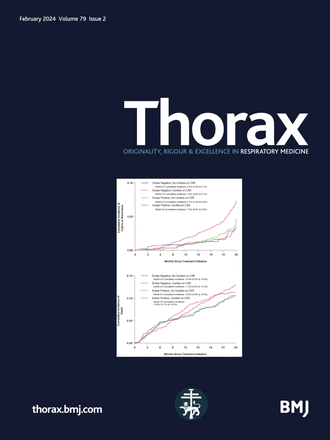计算流体动力学模型预测严重哮喘患者吸入皮质类固醇沉积
IF 9
1区 医学
Q1 RESPIRATORY SYSTEM
引用次数: 0
摘要
一些严重哮喘患者尽管接受了大剂量吸入性皮质类固醇(ICS)治疗,但仍存在持续的2型炎症。严重哮喘患者之间ICS沉积的可变性尚不清楚,这可能是导致这种持久性的原因。目的基于2型炎症、气道形态和气道功能的生物标志物,表征和比较模型预测的重度哮喘患者细颗粒和超细颗粒ICS沉积。方法28例重度哮喘患者于同日行全吸气、全呼气胸部CT,测定2型炎症生物标志物。应用功能呼吸成像和计算流体动力学模拟和预测细颗粒ICS(氟替卡松-丙酸HFA) (ICSFP)和细颗粒ICS(倍氯米松-二丙酸HFA) (ICSEFP)的胸内、中央和周围气道沉积以及中央-周围气道沉积(C:P)比。ct衍生的壁面积百分比(WA%),管腔面积(LA)和粘液负荷被量化以表征气道形态。结果ICSEFP在胸内、中央和外周气道的模拟沉积高于ICSFP(均p<0.0001)。较高的WA%和较小的LA与较高的ICSFP C:P比值相关(r=0.60, P =0.0068;r=−0.60,p=0.0072)和ICSEFP (r=0.54, p=0.028;r =−0.54,p = 0.026)。痰中嗜酸性粒细胞升高的参与者无论颗粒大小,其C:P比都更高(ICSFP, P =0.045;ICSEFP, p = 0.021)。结论在气道壁较厚、气道管腔较窄、2型炎症生物标志物升高的重症哮喘患者中,ICSFP到达外周气道的比例较小。ICSEFP并没有完全缓解这一问题。患者特有的气道形态可能影响局部ICS沉积并导致持续炎症。如有合理要求,可提供资料。本文章由计算机程序翻译,如有差异,请以英文原文为准。
Computational fluid dynamics model predictions of inhaled corticosteroid deposition in patients with severe asthma
Background Some patients with severe asthma have persistent type-2 inflammation despite being treated with high-dose inhaled corticosteroids (ICS). The variability in ICS deposition between patients with severe asthma is not well-understood and could contribute to this persistence. Objectives To characterise and compare model-predicted deposition of fine-particle and extrafine-particle ICS in patients with severe asthma based on biomarkers of type-2 inflammation, airway morphology and airway function. Methods Twenty-eight patients with severe asthma performed full-inspiration and full-expiration chest CT on the same day that biomarkers of type-2 inflammation were measured. Functional respiratory imaging and computational fluid dynamics were used to simulate and predict intrathoracic, central and peripheral airway deposition, and central-to-peripheral airway deposition (C:P) ratio of fine-particle ICS (fluticasone-propionate HFA) (ICSFP) and extrafine-particle ICS (beclomethasone-dipropionate HFA) (ICSEFP). CT-derived wall area percent (WA%), lumen area (LA) and mucus burden were quantified to characterise airway morphology. Results Simulated deposition of ICSEFP was higher than ICSFP in the intrathoracic, central and peripheral airways (all p<0.0001). Greater WA% and smaller LA were correlated with greater C:P ratio of ICSFP (r=0.60, p=0.0068; r=−0.60, p=0.0072) and ICSEFP (r=0.54, p=0.028; r=−0.54, p=0.026). Participants with elevated sputum eosinophils had a greater C:P ratio, irrespective of particle size (ICSFP, p=0.045; ICSEFP, p=0.021). Conclusions In severe asthma patients with thicker airway walls, narrower airway lumens and elevated biomarkers of type-2 inflammation, a smaller ratio of ICSFP reached the peripheral airways. ICSEFP did not fully mitigate this. Patient-specific airway morphology may impact regional ICS deposition and contribute to persistent inflammation. Data are available upon reasonable request.
求助全文
通过发布文献求助,成功后即可免费获取论文全文。
去求助
来源期刊

Thorax
医学-呼吸系统
CiteScore
16.10
自引率
2.00%
发文量
197
审稿时长
1 months
期刊介绍:
Thorax stands as one of the premier respiratory medicine journals globally, featuring clinical and experimental research articles spanning respiratory medicine, pediatrics, immunology, pharmacology, pathology, and surgery. The journal's mission is to publish noteworthy advancements in scientific understanding that are poised to influence clinical practice significantly. This encompasses articles delving into basic and translational mechanisms applicable to clinical material, covering areas such as cell and molecular biology, genetics, epidemiology, and immunology.
 求助内容:
求助内容: 应助结果提醒方式:
应助结果提醒方式:


